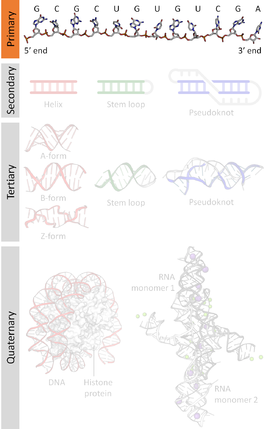
Back تسلسل الحمض النووي Arabic Secuencia d'ADN AST ДНК секвенция Bulgarian Sekvenca nukleinskih kiselina BS Seqüència de nucleòtids Catalan Sekvence nukleové kyseliny Czech Nukleotidsequenz German Αλληλουχία νουκλεϊκών οξέων Greek Secuencia de ADN Spanish توالی اسید نوکلئیک Persian
This article needs additional citations for verification. (March 2014) |


A nucleic acid sequence is a succession of bases within the nucleotides forming alleles within a DNA (using GACT) or RNA (GACU) molecule. This succession is denoted by a series of a set of five different letters that indicate the order of the nucleotides. By convention, sequences are usually presented from the 5' end to the 3' end. For DNA, with its double helix, there are two possible directions for the notated sequence; of these two, the sense strand is used. Because nucleic acids are normally linear (unbranched) polymers, specifying the sequence is equivalent to defining the covalent structure of the entire molecule. For this reason, the nucleic acid sequence is also termed the primary structure.
The sequence represents genetic information. Biological deoxyribonucleic acid represents the information which directs the functions of an organism.
Nucleic acids also have a secondary structure and tertiary structure. Primary structure is sometimes mistakenly referred to as "primary sequence". However there is no parallel concept of secondary or tertiary sequence.
© MMXXIII Rich X Search. We shall prevail. All rights reserved. Rich X Search